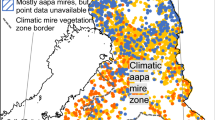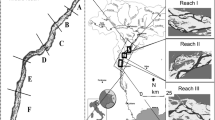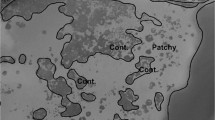Abstract
During its spring and fall migrations, the Greater Snow Goose (Chen caerulescens atlanticus) stages in the marshes along the St. Lawrence Estuary in southern Quebec, where it feeds on three-square bulrush (Schoenoplectus americanus) rhizomes. The goose population has grown from 70 000 birds to around one million over the last 40 years, thus increasing pressure on these tidal marshes. To determine the impact of geese on the ecological integrity of the marshes over this period, we used IKONOS satellite imagery and aerial photographs to classify vegetation types. We estimated changes in bulrush cover using the eCognition image analysis software (Trimble). We examined the spectral, textural, and contextual characteristics of the identified classes. The proportion of bulrush cover has declined significantly in the lower marsh since around 1980, and bulrush has been gradually replaced by wild rice (Zizania aquatica var. brevis). We also documented the erosion between the lower and upper marshes along most of the shoreline.





Similar content being viewed by others
References
Bélanger L, Bédard J (1994a) Role of ice scouring and goose grubbing in marsh plant dynamics. Journal of Ecology 82:437–445
Bélanger L, Bédard J (1994b) Foraging ecology of greater snow geese, Chen caerulescens atlantica, in different Scirpus marsh plant communities. Canadian Field-Naturalist 108:271–281
Bélanger L, Bédard J (1995) Use of ice-scoured depressions by marsh-foraging snow geese (Chen caerulescens atlanticus). Canadian Journal of Zoology 19:252–259
Bélanger L, Lefebvre J (2006) Sustainable integrated management of the Greater Snow Goose in Quebec: 2005–2010 Action Plan. Canadian Wildlife Service, Environment Canada, Sainte-Foy, 34 pp
Bernatchez P, Dubois J-MM (2004) Bilan des connaissances de la dynamique de l’érosion des côtes du Québec maritime laurentien. Géographie physique et Quaternaire 58:45–71
Blaschke T (2003) Object-based contextual image classification built on image segmentation. IEEE Advances in Techniques for Analysis of Remotely Sensed Data, pp 113–119
Dauphin D (2000) Influence de la navigation commerciale et de la navigation de plaisance sur l’érosion des rives du Saint-Laurent dans le tronçon Cornwall-Montmagny. Ministère des transports du Québec, Saint-Laurent Vision 2000
Dionne JC (1986) Érosion récente des marais intertidaux de l’estuaire du Saint-Laurent. Géographie physique et Quaternaire 40:307–323
Dionne JC, Bouchard MC (2000) Nouvelles données sur l’érosion du schorre supérieur à Montmagny, moyen estuaire du Saint-Laurent. Géographie physique et Quaternaire 54:219–230
Fournier RA, Grenier M, Lavoie A, Hélie R (2007) Towards a strategy to implement the Canadian Wetland Inventory using satellite remote sensing. Canadian Journal of Remote Sensing 33:S1–S16
Giroux J-F, Bédard J (1987) The effects of grazing by greater snow geese on the vegetation of tidal marshes in the St. Lawrence estuary. Journal of Applied Ecology 24:773–788
Giroux J-F, Bédard J (1988a) Estimating above- and below-ground macrophytes production in Scirpus tidal marshes. Canadian Journal of Botany 66:368–374
Giroux J-F, Bédard J (1988b) Use of bulrush marshes by greater snow geese during staging periods. Journal of Wildlife Management 52:415–420
Giroux J-F, Bédard J (1995) Seed production, germination rate and seedling establishment of Scirpus pungens in tidal brackish marshes. Wetlands 15:290–297
Grenier M, Demers A-M, Labrecque S, Benoit M, Fournier RA, Drolet B (2007) An object-based method to map wetland using RADARSAT-1 and Landsat ETM images: test case on two sites in Quebec, Canada. Canadian Journal of Remote Sensing 33:S28–S45
Grenier M, Labrecque S, Benoit M, Allard M (2008) Accuracy assessment method for wetland object-based classification, GEOBIA 2008 proceedings, University of Calgary, Canada
Jano AD, Jefferies RL, Rockwell RF (1998) The detection of vegetational change by multitemporal analysis of LANDSAT data: the effects of goose foraging. Journal of Ecology 86:93–96
Jensen JR (2005) Introductory digital image processing: a remote sensing perspective, 3rd edn. Prentice Hall, Upper Saddle River
Kent BJ, Mast JN (2005) Wetland change analysis of San Dieguito Lagoon, California, USA: 1928–1994. Wetlands 25:780–787
Kurtz C, Passat P, Gançarski P, Puissant A (2012) Extraction of complex patterns from multiresolution remote sensing images: a hierarchical top-down methodology. Pattern Recognition 45:685–706
Lacombe J (1982) Analyse de l’évolution spatiale des marécages intertidaux de l’estuaire moyen du Saint-Laurent, 1960–1980. Rapport présenté au Service canadien de la faune, Environnement Canada, par le Groupe DRYADE. Quebec, Canada
Lefebvre J, Reed A, Giroux J-F, Plante N, Bélanger L (2001) Suivi de la végétation du marais à scirpe de la Réserve nationale de faune du Cap Tourmente (1971–2000). Canadian Wildlife Service, Environment Canada, Quebec, Canada
Lunetta RS, Lyon JG (2004) Remote sensing and GIS accuracy assessment. CRC Press, Boca Raton
Miller DL, Smeins FE, Webb JW (1996) Mid-Texas coastal marsh change (1939–1991) as influenced by lesser snow goose herbivory. Journal of Coastal Research 12:462–476
Okeke F, Karnieli A (2006a) Methods for fuzzy classification and accuracy assessment of historical aerial photographs for vegetation change analyses. Part 1: Algorithm development. International Journal of Remote Sensing 27:153–176
Okeke F, Karnieli A (2006b) Methods for fuzzy classification and accuracy assessment of historical aerial photographs for vegetation change analyses. Part 2: Practical application. International Journal of Remote Sensing 27:1825–1838
Smith TJ III, Odum WE (1981) The effects of grazing by snow geese on coastal salt marshes. Ecology 62:98–106
Touzi RA, Deschamps A, Rother G (2007) Wetland characterization using polarimetric RADARSAT-2 capability. Canadian Journal of Remote Sensing 33:S56–S67
Townsend PA (2000) A quantitative fuzzy approach to assess mapped vegetation classifications for ecological applications. Remote Sensing of Environment 72:253–267
Woodcock CE, Gopal S (2000) Fuzzy set theory and thematic maps: accuracy assessment and area estimation. International Journal of Geographical Information Science 14:153–172
Acknowledgments
This study is part of a larger project funded by the Arctic Goose Joint Venture. The IKONOS images used in this study were kindly provided by Guy Létourneau of the St. Lawrence Centre of Environment Canada in Montréal. Thanks also to Léo Provencher of the Department of Applied Geomatics at the Université de Sherbrooke for his most useful advice over the course of this project.
Author information
Authors and Affiliations
Corresponding author
Rights and permissions
About this article
Cite this article
Allard, M., Fournier, R.A., Grenier, M. et al. Forty Years of Change in the Bulrush Marshes of the St. Lawrence Estuary and The Impact of the Greater Snow Goose. Wetlands 32, 1175–1188 (2012). https://doi.org/10.1007/s13157-012-0347-z
Received:
Accepted:
Published:
Issue Date:
DOI: https://doi.org/10.1007/s13157-012-0347-z




